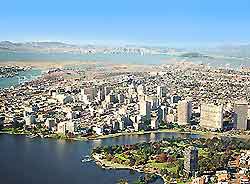Oakland’s pot dreams could burst

By Cecily Burt
Oakland Tribune
OAKLAND — Oakland rushed last week to raise medical cannabis business taxes and to be the first city in the nation to legitimize industrial-sized pot production. The cash-starved city is hoping to reap millions of dollars in tax revenues from medical cannabis businesses while positioning itself to capitalize on the explosion of recreational pot sales should state voters go that way in November.
But is it just a pipe dream? No one really knows whether Oakland will find that pot of gold in the cannabis industry. Growers and dispensaries are making money, to be sure, and the city wants its share. But competition, legal risks and the unknown economic effects from potential legalization make the sure bet anything but.
California voters in 1996 overwhelmingly passed Proposition 215, the so-called Compassionate Use Act, which decriminalized medicinal use of marijuana. Dispensaries popped up almost overnight, supplied by a cottage industry of growers selling pounds of pot for $2,500 to $3,500, tax-free. Retail prices are double that, but not enough to stop the flood of patients willing to spend more than $300 an ounce for high-grade marijuana.
The estimated value of California’s pot crop is $13.8 billion, according to an analysis for California NORML, a nonprofit organization devoted to marijuana reform. About 3 million people in the state use marijuana, medical and recreational, and consume an estimated 1 million pounds a year.
four medical marijuana dispensaries do their share, supplying patients with 6,000 pounds of pot worth $28 million last year. The city is asking voters to raise business taxes on medical marijuana sales to 5 percent, a rate that dispensaries, patients and small growers warn will drive them out of Oakland and into neighboring communities with lower tax rates or no taxes at all.
The four new industrial-sized farms the city plans to license in January should do well, given the growing demand for medical marijuana across the state. But the ventures are not without risk. State law allows medical marijuana cultivation by collectives of patients and caregivers, with no profiteering.
Although the Obama administration has pledged a hands-off approach to honor states’ laws, several experts warn that the federal government may not be able to ignore commercial-sized growing and manufacturing plants, which are not allowed under current state law.
That is a concern expressed by Oakland Councilmember Nancy Nadel, who sees pros and cons in the plan and worries about excluding small growers. “I was willing to go along with some large growers, but is this an invitation to federal attention? It puts a lot of product in one space, so if there is a fire, or theft, or mold, you could impact the availability of product to the patients,” Nadel said.
New tax revenue
Still, it’s easy to see why the City Council majority backs the concept of large indoor farms. Regulating medical marijuana production in modern facilities located in industrial areas should ensure a reliable, consistent supply of high-grade marijuana. It conceivably should cut down on the hundreds of dangerous, illegal grow houses spread around Oakland, especially if the huge growers can offer lower wholesale prices. It also makes it easier for the city to track the money.
Perhaps the most convincing argument arrived in a report commissioned by Jeff Wilcox, a retired contractor who first approached city leaders about the commercial grow idea. His proposal for a 100,000-square-foot AgraMed cultivation facility would produce 21,000 pounds of pot with a wholesale value of $60 million. That translates into $3 million in new tax revenue for the city and 300 to 400 jobs for Bay Area residents — from just one business.
That’s on top of the revenue the city will get from its four dispensaries. If sales remain static, the city stands to gain another $1.4 million.
Dale Gieringer, director of California NORML, says Oakland is smart to get ahead of the curve, and it could gain millions in new tax revenue if the city’s sales and production estimates pan out. But setting too high of a tax rate could backfire initially, and he thinks that establishing the large-scale production facilities will be neither quick nor problem-free.
“I think there is a risk here on jumping ahead on this tax on medical marijuana,” Gieringer said. “San Francisco doesn’t have a tax. At 5 percent, this gives other places an advantage. Oakland could be in danger of killing the goose that lays the golden egg. Patients will not go to Oakland if they can go to San Francisco and get it cheaper.”
Oakland might have been the first to realize the revenue benefits of taxing medical marijuana businesses, but several other economically strapped municipalities are following its lead. San Jose, Richmond and others are scrambling to place similar tax measures on the November ballot. Berkeley is asking voters to raise cannabis tax rates as well as allow up to six commercial cultivation facilities.
Oakland’s four proposed cultivation permits are intended for medicinal production only — for now. The proposal also lays the framework should Proposition 19 pass in November, legalizing recreational use of pot for adults 21 and older. The city is asking voters in November to set the business tax rate for recreational sales at a whopping 10 percent.
But will it be a bonanza or bust?
Legalized pot
According to a RAND Corp. study released this month, legalization could boost the number of pot smokers and drive down the pretax price of an ounce of pot by as much as 80 percent. The authors warn that it potentially could fuel problems with smuggling as dealers from other states rush to buy low-cost cannabis in California.
“Legalization would drive the price so low that even if taxes are high, marijuana coming from California would still be cheaper than a lot of places in the country,” said Beau Kilmer, lead author of the study and co-director of the Drug Policy Research Center. “If dealers come here to buy several pounds, pay the taxes and then smuggle it out, they would still make money.”
Even with hefty state or local taxes added on, consumers likely would pay hundreds of dollars less than they do now. That’s good news for patients who rely on the herb to ease their pain, control their nausea or boost their appetite, but it could put a huge dent in the amount of tax revenue the city collects from its medical marijuana dispensaries.
If the wholesale price of medical marijuana drops to $800 a pound, a scenario Wilcox said could happen, the city’s cut would drop to $1.35 million.
“Right now there’s an 85 percent profit margin (enjoyed by the growers and dispensaries), and that’s too high, in my opinion,” Wilcox said. “If you can grow for $400 and sell it $800 wholesale, people will be doing just hunky-dory.”
Oakland Councilmember Desley Brooks said she’s not pinning all her expectations on legalization, especially when there is plenty of revenue to be had from the medical cannabis industry.
“There’s a lot of money in that industry and not a lot of regulation,” she said.
Kilmer said his work focused on what might happen if marijuana were legalized in California. The Regulate, Control and Tax Cannabis Act 2010 ballot initiative would allow people 21 and older to possess, grow or transport small amounts of pot for personal use. Cities and counties could choose whether to regulate and tax the commercial cultivation and sales of marijuana or to keep such activities illegal.
“The impacts of legalization on medical marijuana is unknown,” Kilmer said. “But it will be interesting to see what happens in Oakland because it’s unclear what the feds will do” about the commercial growers.
Mark Kleiman, a UCLA professor of public policy who has written extensively on the topic, believes cities such as Oakland that are hoping to cash in on medical marijuana, and legalization if it happens, should try to see through the dollar signs to the possible pitfalls.
“Yes, (Oakland is) in for a big letdown,” he said. “Competition among growers and among jurisdictions would drive legal prices through the floor, leaving California with a large (illegal) export trade to the rest of the country and not much revenue. The feds wouldn’t hold still for it and would crack down.”
